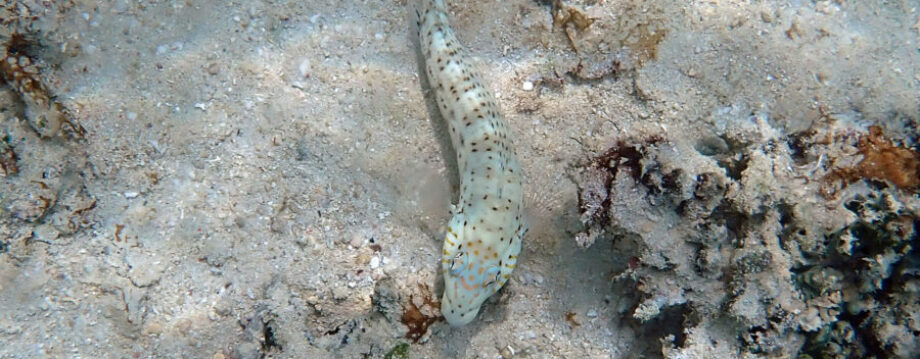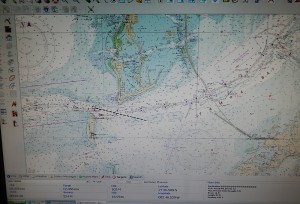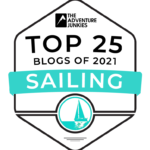I am selling a lot of stuff on eBay getting ready for our downsize. Items that we figure we do not want to keep or store. We had a huge construction dumpster at the house a couple of weeks ago and we filled it up in one day. It is truly amazing how much junk we have accumulated in the 18 years in this house. The money I get from sales on eBay is being used to upgrade some of the navigation electronics on the boat. This is kind of a fun way to purchase stuff. Once I get enough money in my PayPal account, I pick something from my wish list and tackle an upgrade project.
We recently installed Type B AIS onto Cream Puff. AIS stands for: Automatic Identification System. This is a great navigational safety aid. In my opinion, it is the best invention in nautical navigation since GPS. We would not be caught without it. Here’s how it works. The little AIS black box has a built in GPS (global positioning system). From the GPS, it can calculate our location, speed and direction. The little black box also has our vessel name, type, ships radio station ID, length, width, draft and MMSI number (Maritime Mobile Service Identity – a global number unique to our boat). The AIS is also a VHF radio and every few seconds will transmit all of this information digitally on a dedicated VHF radio frequency. Thus, all the vessels around us within a 10 +/- mile range with AIS onboard will be able to “see” us. And, those vessels equipped with AIS will transmit their information. The data we receive is overlaid onto our electronic navigation charts.
All commercial vessels are now required to have AIS. The real advantage to us is we will show up on their screen with our data. If we are in the way of a ship, an alarm will go off. They can hail us by name on the radio rather than, “sailing vessel located at blah blah blah”. It is sort of like your phone ringing when someone needs to talk to you.
How is this different from radar you ask? On radar, we can see anything giving off a reflection. The radar blips can also be overlaid to our electronic navigational charts. However, all we see is a blip. We can tell if the blip is moving, if it is in our way or just a passing ship in the night. However, we have no idea what the blip actually is until we make visual contact. It could be a small fishing boat or a huge tanker. With AIS, we can see all the details and call the vessel by name. We can ask them over the radio if they see us and what their navigational intentions are. Pretty cool, huh?
Left, is a screen shot of our navigation monitor. Toward the left side you can see ships entering into Tampa Bay guided by the Tampa Bay Pilot. The dotted line in front of the ship is a projection of the ship’s position in 15 minutes based on the speed and direction. On the bottom of our monitor, we can see the AIS: Tampa which is the Tampa Bay Pilot boat doing 16.9 knots on a heading of 102 degrees located 12.356 nautical miles from us at a bearing of 224 degrees.
There are 3 types of AIS units available in Class A and B devices.
• Type A: This equipment includes a 12.5watt VHF transmitter (typical 20-40 mile range, mostly depending on antennae height), a dual channel receiver and either a built in GPS or port to external GPS. It can transmit and receive the full complement of AIS information. Type A is required on IMO/SOLAS commercial vessels.
• Type B: Designed to provide less expensive AIS functionality for smaller commercial vessels and pleasure vessels. This equipment also includes a VHF transmitter, a dual channel receiver and is required to have a built in GPS. However, transmission power is restricted to 2W, giving a typical range of about 5 – 10 miles. In addition, only a subset of the possible AIS information (for instance, not destination, ETA, draft, navigational status) is transmitted at a reporting rate less than a Class A (e.g. every 30 sec. when under 14 knots, as opposed to every 10 sec. for Class A). Type B does not meet the SOLAS standards but does meet ISAF OSR Cat 1 & 2 requirements.
• Type B Receive-only: Inexpensive, low power systems that only receive information from other vessels and do not transmit any information about the vessel they are installed on. Does not meet ISAF OSR Cat 1 & 2 requirement.
The installation was very painless. Prior to purchasing an Amel, I once read a posting by Bill Rouse from BeBe. He said on the Yahoo Amel Owners Group he appreciated Henri Amel’s forward thinking design and the ease to access normally hard to reach places. I have to agree. On our previous boat, to run an antenna wire from the stern to the navigation station at mid-ships would have required removal of ceiling panels, teak flooring or drilling through wood bulkheads (walls). Henri had the foresight to have a conduit tube built into the structure. The Amel boat building yard had already installed a nylon string to pull wire through the tube. We attached a new string (to use next time) and our antennae cable to the string and simply pulled it through the tube to the navigation station. We couldn’t believe how easy this part of our project was. Thanks Henri!
I have a very long shopping list and lots more stuff to sell on eBay. One day at a time….



